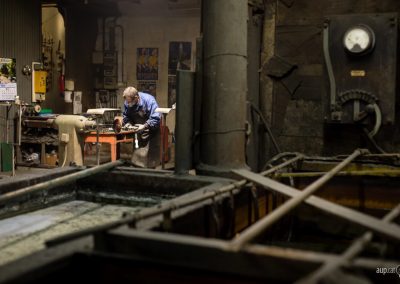P2: La Muralla (The wall)
Second stop
La Muralla (The wall)
The limestone rock is mostly composed of calcium carbonate (CaCO3) and, in the case of the so-called Girona stone, it often contains small marine organisms such as nummulites, which indicates that these rocks formed in a marine environment.
The carbonates react with dilute acids to give rise to carbon dioxide and the corresponding calcium salt. This process helps the chemical weathering of the rocks.
From this point, you can see several Modernist tiles, enamel tiles that are mostly green or yellow.
In the eighteenth and nineteenth centuries there was a change due to two discoveries that allowed for the manufacture of a strong, hard hydraulic cement that did not dissolve in water. These discoveries led to the creation of Portland cement, a basic material used to make concrete (mixed with stones and sand), mortar (mixed with fine sand), and stucco (mixed with chalk).
Did you know?
Marble is a rock that has the same chemical composition as limestone, that is, mostly calcium carbonate. Its appearance is different because it has been formed under different conditions, especially under higher pressure. Marble has been widely used as kitchen counter tops due to its ease of being cut into sheets and also because of its beauty, especially when polished. Over time, other materials have become popular, such as granite and sandstone.
The economic factor has an effect: years ago it was easier to obtain and work with marble, but it has some drawbacks. It reacts with acids and it is easily stained because it is quite porous. In the kitchen, some acids that can stain the marble are used frequently. Lemon juice contains ascorbic acid (vitamin C), and vinegar, acetic acid: two enemies of calcium carbonate.
Walls
See for example:
La Pedra de Girona. David Brusi.
Col·lecció Itineraris.
Edita l’Ajuntament de Girona.

Pedra de Girona
See for example:
La Pedra de Girona. David Brusi.
Col·lecció Itineraris.
Edita l’Ajuntament de Girona.

Calç
La calç procedeix de la descomposició pel calor de les roques calcàries a temperatures per sobre dels 900ºC a 1200ºC de la qual es desprèn diòxid de carboni i s’obté l’òxid de calci calç viva):
CaCO3 —> CO2 + CaO
Quan s’afegeix aigua a la calç viva s’obté la calç hidratada o hidròxid de calci Ca(OH)2, en un procés que desprèn calor. Quan es col·loca, segueix l’augment de la temperatura i un augment de la viscositat. La massa comenta a endurir-se, perdent la seva plasticitat, en un procés que pot durar tres o quatre mesos. En acabar aquest procés la mescla tindrà la consistència d’una roca. Aquest material segueix endurint perquè absorbeix el diòxid de carboni de l’aire produint-se paral·lelament la carbonatació, procés que pot durar anys, i fins i tot segles, i pel qual la calç torna al seu estat primitiu, el carbonat càlcic.

Argiles
Les argiles són un component essencial del sòl. El essers humans les han utilitzat des de fa mil·lennis om a matèria prima per fer estris com peces de ceràmica, maons, rajoles, etc. Les argiles estan formades per partícules generalment molt fines que provenen de la meteorització i descomposició de roques ígnies.
Quan es barregen amb aigua, les argiles es tornen toves, plàstiques i es poden modelar. L’aigua responsable de donar aquestes característiques plàstiques es pot treure si s’escalfa a uns 100ºC i l’argila llavors es torna rígida i trencadissa (és el que passa quan es deixa assecar l’argila al sol). Si s’escalfa per sobre d’uns 950ºC, es comença a formar un compost anomenat mullita (Al6Si2O13) i apareixen estructures vidrioses.

Esmalt
L’esmalt és el resultat de la fusió de cristalls en pols amb un substrat a través d’un procés d’escalfament, normalment entre 750 i 850 ºC. La pols es fon s’endureix formant una cobertura suau i vidrada molt duradora. Sovint s’aplica l’esmalt en forma de pasta, i pot ser transparent o opaca.
L’esmalt brillant o vidrat té moltes propietats excel·lents. És suau, resistent a les agressions mecàniques o químiques, durador, pot mantenir colors brillants durant molt temps i no és combustible. La brillantor li ve donada per l’aplicació de compostos que contenen plom, mentre que el color depèn de diversos factors. Principalment, el pigment que s’utilitza, però també depèn de la temperatura i de l’atmosfera en què es cou la ceràmica.
Per exemple, els pigments basats en ferro poden adquirir colors que van del verd, groc, marró o negre, els basats en manganès poden ser porpres o marrons, els de crom varien entre el rosa i el verd, mentre que els de coure es mouen entre color verd i blau.

Portland
El ciment portland s’obté escalfant una mescla de roques calcàries (o guix, petxines, etc) amb aluminosilicats com sorra, esquists o argiles en proporció adequada per donar una composició d’un 90% en òxid de calci i òxid de silici (CaO i SiO2). El 10 % restant són, sobretot, òxids d’altres elements.
És el tipus de ciment més emprat en construcció, ja que és un component bàsic en la producció de formigó, morter i estucat i té la propietat d’endurir-se amb molta rapidesa.
- Formigó: Material de construcció constituït per una barreja de grava, sorra, aigua i ciment pòrtland que inicialment constitueix una substància plàstica i mal·leable. Quan aquesta pasta s’endureix esdevé una massa dura que s’empra en construcció.
- Formigó armat: Formigó a l’interior del qual hom disposa barres cilíndriques metàl·liques, destinades a resistir esforços de tracció o de flexió, que el formigó ordinari no suportaria bé .
Gràcies a materials com aquests, ha estat possible la construcció dels grans gratacels.



















